Live Plants in Fish Tank With Gravel Updated
Live Plants in Fish Tank With Gravel
Yous might be wondering whether your tank plants can be grown buried in a gravel substrate. In truth, this depends on what species of constitute you take. Generally, gravel is a great cloth to grow plants in. But simply certain flora will grow in this substrate well.
There are many aquarium plants that do well in gravel. The following plants will flourish in gravel, with the right intendance and maintenance:
- Amazon Sword (Echinodorus grisebachii)
- Madagascar Lace (aponogeton madagascariensis)
- Cryptocoryne Wendtii
- Java fern
- Ruby-red Tiger Lotus
- Anubias
- Vallisneria
- Bucephalandra
- Waterweeds (Anacharis elodea)
- Dwarf Sagittaria
Lucky for you, I did some research on plants that grow in gravel. There are some important tips that I tin give y'all for each plant to brand growing them a success! I know what a bummer it can be if plants are non doing well, and so I will endeavour to help you the all-time I can.
My three favorites for a gravel substrate are the following:
Now let's cover all plants in more item.
i. Amazon Sword (Echinodorus grisebachii)
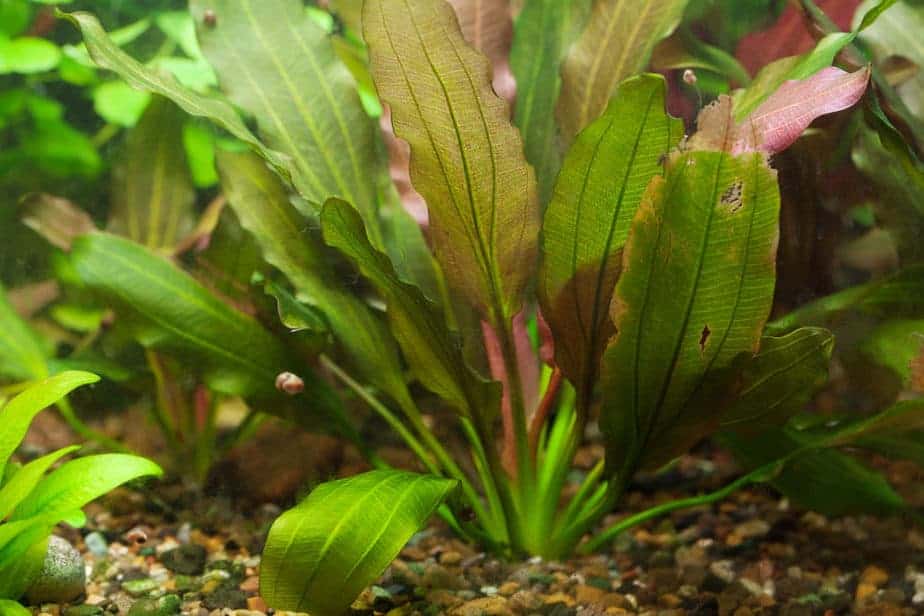
| Common name: | Amazon Sword |
| Scientific proper noun: | Echinodorus grisebachii |
| Max height: | sixteen in / xl cm |
| Care complexity: | Like shooting fish in a barrel |
| Lighting needs: | Medium to Loftier |
| Growth rate: | Moderate |
| Additional CO2 required: | No |
| Recommended position: | Background establish |
| Fertilization: | Root tabs |
| Availability: | Buy on Amazon |
The first gravel plant I will innovate is the Amazon Sword. This is a great starter establish that won't requite beginners a hard time. It requires moderate levels of low-cal and can survive well in a range of temperatures.
Tip: a lot of these plants are likewise on my listing of bully aquatic plants for beginners. If yous're looking for more inspiration, check out the listing here.
This plant as well looks great in your aquarium. It has long sword-similar leaves that tin can be grown in the background of your tank, or it can be placed in the middle of your tank alone as a centerpiece. With lilliputian maintenance, this flora will grow long and sturdy.
Simply brand sure to put plenty gravel in your tank to root your found. You lot want a little under three inches, around 2.5 inches to exist exact, and the gravel should be loosely packed every bit well. In brusque, don't plant the roots deep. Give them infinite to grow because they will go large! Also, brand sure to provide enough nutrients by calculation root tabs on a regular ground. Once every three months should suffice.
Before we movement to the next plant, I must tell you a bit more on taking care of plants. If you don't know how to add the right type of fertilizer for example, your plants will slowly die after adding them to your tank.
How to Feed Aquarium Plants in Gravel
The fact is that plain gravel contains no nutrients for your plants, at to the lowest degree not when it'due south new and direct out of the bag. This is something y'all should take into account because I really recommend adding some form of establish fertilizer to your tank.
The easiest way, and the fashion that I do it in all my tanks, is adding liquid institute fertilizer. This is something that you add at least in one case a week (just more often is ameliorate) and it allows your plants to suck food direct out of the water. Although your fish do produce some plants nutrient (poop), it'southward not enough to provide for your plants.
The liquid fertilizer that I take been recommending for years is from the brand API which they phone call Leaf Zone. It's an all-in-one plant fertilizer that will non let you down. Check it out here on Amazon.
Other options are changing to aquarium soil instead of gravel, which is expensive and, in my opinion, not worth it. You lot tin also add root tabs, which are tablets that incorporate nutrients that you tin push down in the gravel near the roots of your plant. I just add root tabs to heavy root feeding plants.
The root tabs from API are very skillful at feeding root feeding plants. Check them out hither if you lot don't have root tabs all the same.
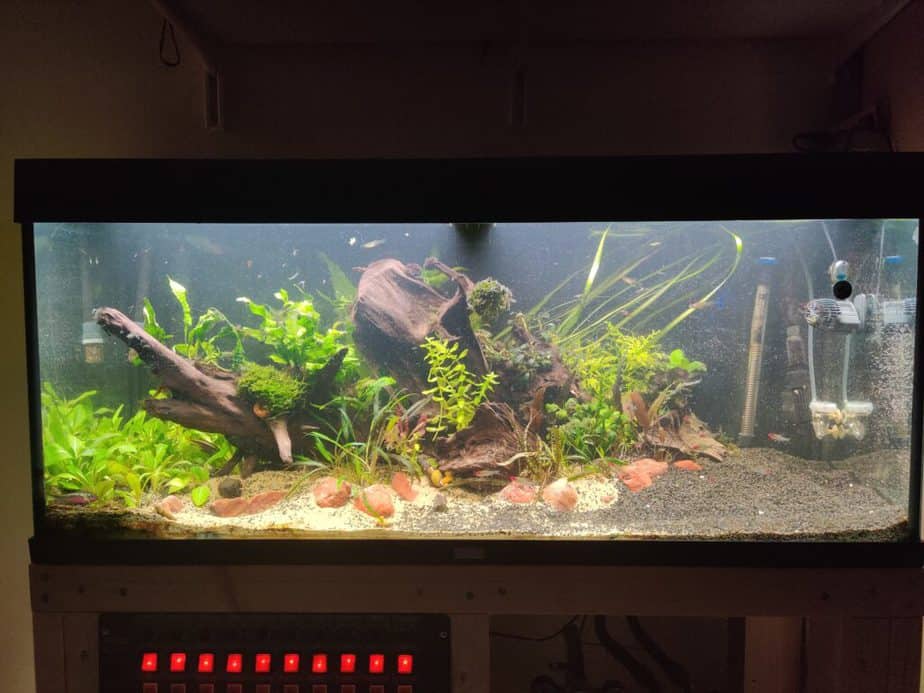
To my tank, which yous tin see on the moving picture, I add liquid fertilizer on a weekly basis. For the plants that need root tabs, such as Amazon swords, I regularly add new root tabs. I endeavour to button a new root tab in the gravel near the roots every 3 months.
Let'due south motility to the next plant on the list!
2. Republic of madagascar Lace (aponogeton madagascariensis)
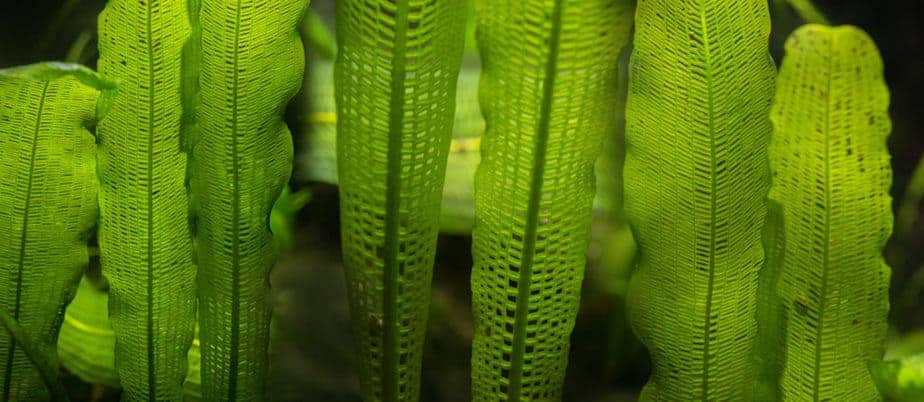
| Common name: | Madagascar Lace |
| Scientific name: | Aponogeton Madagascariensis |
| Max height: | 8 in / 20 cm |
| Care complication: | Easy |
| Lighting needs: | Low to Moderate |
| Growth rate: | Tiresome to Moderate |
| Boosted CO2 required: | No |
| Recommended position: | Midground institute |
| Fertilization: | Root tabs |
| Availability: | Buy on Amazon |
Madagascar Lace can grow well in gravel also, but it isn't a simple institute to intendance for. Y'all volition need to make sure your plant has the correct atmospheric condition to accommodate its growth.
Water temperature can be on the colder side, around 60 to seventy degrees Fahrenheit, though they can handle higher temperatures when you desire them to flower. Calorie-free requirements are medium to high for this plant. More light will let your constitute grow faster, then I recommend using higher levels of light. Still, the light intensity is up to you.
This establish can get quite large and if you desire it smaller lower lite tin be helpful.
In add-on, the Lace should likewise be planted properly in the gravel. You don't desire to bury this in deep gravel. But two inches of substrate is required for this institute. Fertilizer should as well be added to your gravel to proceed the Lace thriving in your h2o!
3. Cryptocoryne Wendtii
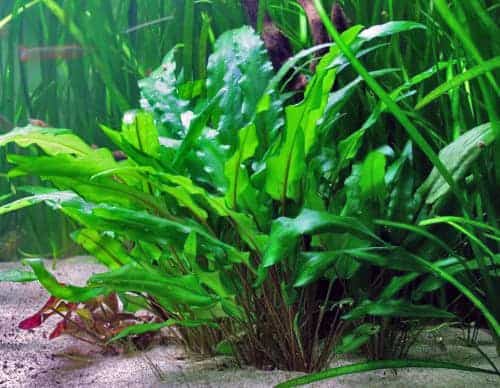
| Mutual name: | Crypt. Wendtii |
| Scientific name: | Cryptocoryne Wendtii |
| Max height: | 6 in / fifteen cm |
| Care complication: | Easy |
| Lighting needs: | Low to Moderate |
| Growth rate: | Slow |
| Additional CO2 required: | No |
| Recommended position: | Foreground / Midground plant |
| Fertilization: | Root tabs |
| Availability: | Buy on Amazon |
Cryptocoryne is popular in planted aquariums lined with gravel just also does great in sand. The nice thing about this plant is that it comes in a few unlike colors. So y'all won't be limiting yourself to green plants, considering there is also a ruddy crypt. wendtii variation!
If you are curious about what plants grow well in sand, check out this article on my site!
Care is fairly simple with the Wendtii. It'south a strong plant that likes many water conditions. Low lighting is preferred past this institute, and it can live in a range of Ph levels as well.
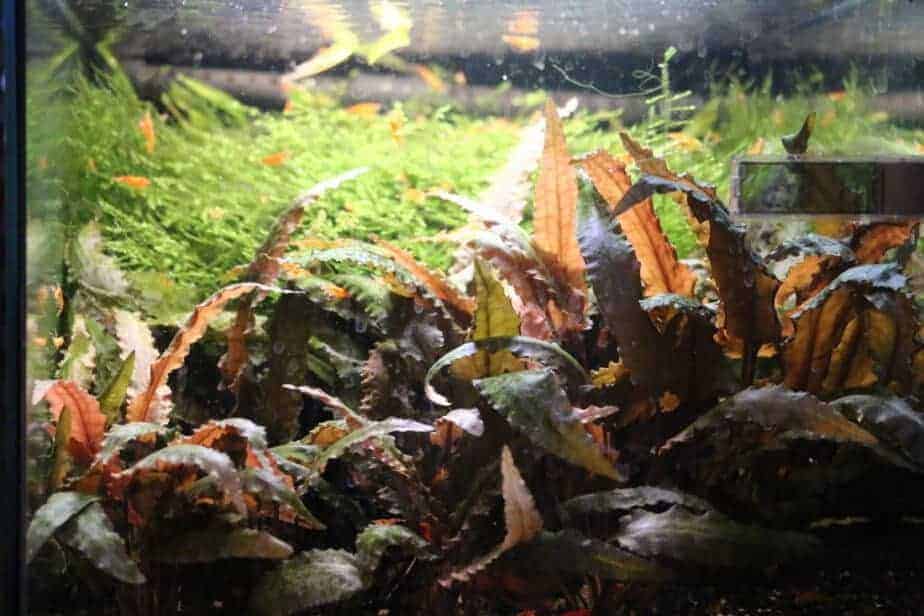
While this is an undemanding plant, y'all will need to root it downwardly as soon as you can. Wendtii plants course large root systems, so gravel is an ideal substrate choice for the species. Make sure the roots are firmly placed, and make sure you lot have plenty of gravel set into your tank. At least three inches!
This is one of the plants for which I would recommend calculation root tabs. From my personal experience, I can tell you that crypts do way amend later adding a root tab. If you don't have any withal, check out these root tabs from API on Amazon.
iv. Coffee fern
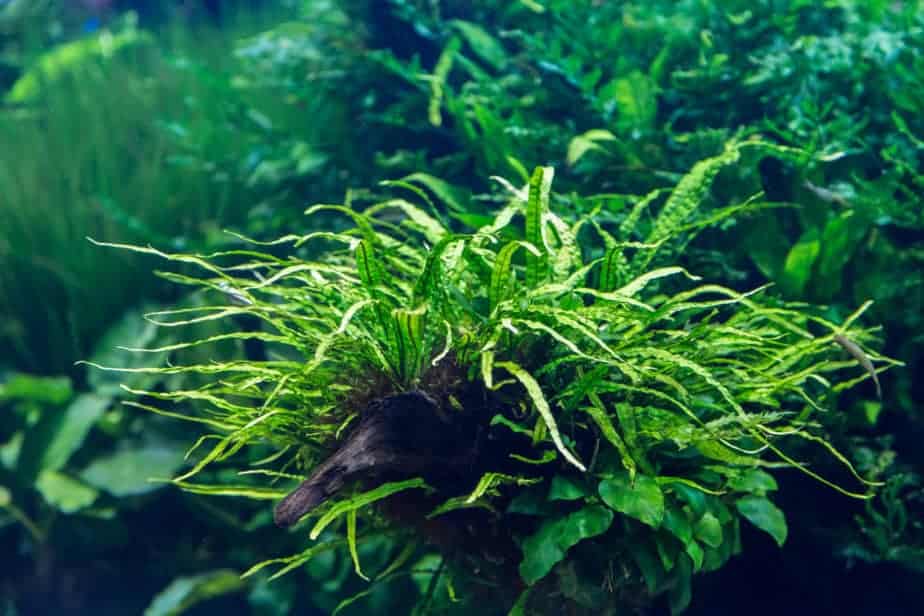
| Common name: | Java Fern |
| Scientific name: | Microsorum Pteropus |
| Max peak: | 13.5 in / 35 cm |
| Care complexity: | Easy |
| Lighting needs: | Low |
| Growth rate: | Tiresome |
| Additional CO2 required: | No |
| Recommended position: | Midground / Background plant |
| Fertilization: | Liquid fertilizer |
| Availability: | Purchase on Amazon |
Java Fern is another bully option for new plant owners. Ferns grow well in gravel and require low levels of fertilizer to thrive. You can grow many of these in your tank with a fairly low level of maintenance.
This is because Java fern adapts to almost any blazon of environment. They like very low concentrations of calorie-free and abound in a range of temperatures.
Your fish will too enjoy having these plants in their tank environment. The leaves of the Fern are large and provide plenty of coverage for all types of pets. Coffee doesn't abound super-fast, but over time you can have a whole tank full of these full flora.
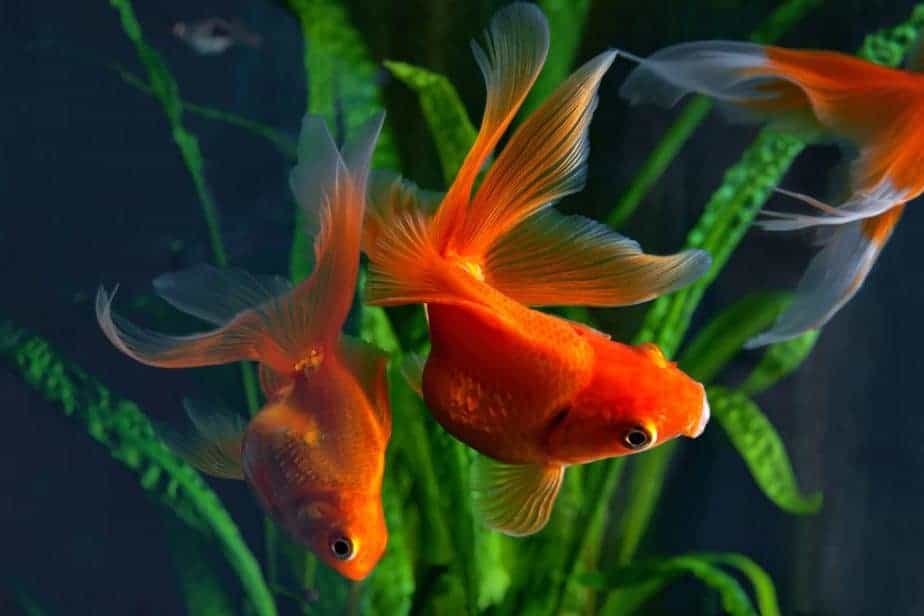
Again, in that location isn't much to worry about in terms of care, just prune this found and get rid of whatever found waste. Also, consider the lighting, also much light can impale Java Fern. And in terms of gravel, don't put the roots of the fern too deep into your substrate. Gravel is a dandy way to root these plants down, just if yous put this plant in as well deeply it will die. Smaller gravel with some fertilizer will create the best plant growth.
v. Red Tiger Lotus
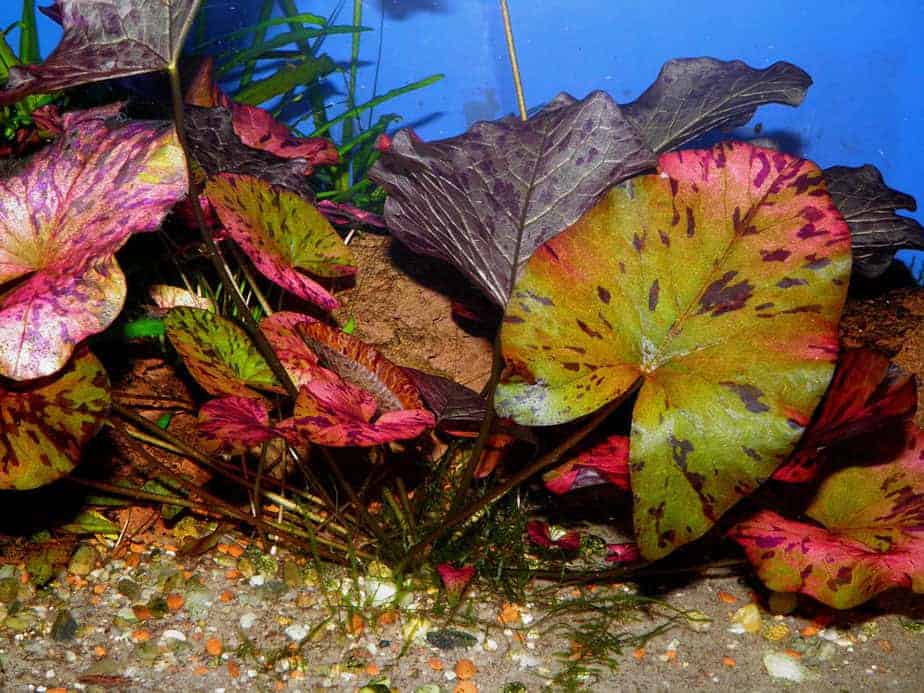
| Common name: | Red Tiger Lotus, Dwarf Lilly |
| Scientific name: | Nymphaea Zenkeri |
| Max height: | xx+ in / 50+ cm (under platonic circumstances) |
| Intendance complexity: | Moderate |
| Lighting needs: | Moderate to High |
| Growth charge per unit: | Moderate to Fast |
| Additional CO2 required: | Yep (just tin be done without) |
| Recommended position: | Midground / Background plant |
| Fertilization: | Root tabs and Liquid fertilizer |
| Availability: | Buy on Amazon |
Red Tiger Lotus is a popular flowering plant, merely it can also grow in gravel. If yous choose to grow it underwater and grounded, you won't encounter flowers form. However, you will become a good visual from this plant species.
Tiger Lotus are non difficult plants, simply you need to found them correctly for the best results. Make sure to get the roots buried in gravel, but do not comprehend the seedling of this plant. Otherwise, your Tiger will not grow correct. Furthermore, make sure your gravel is infused with plenty of fertilizer. This species needs plenty of nutrients to live in the water.
Warmer climates are preferred past this plant, and medium levels of calorie-free should exist used. More importantly, make certain to trim this plant, because information technology grows apace if left unattended!
6. Anubias
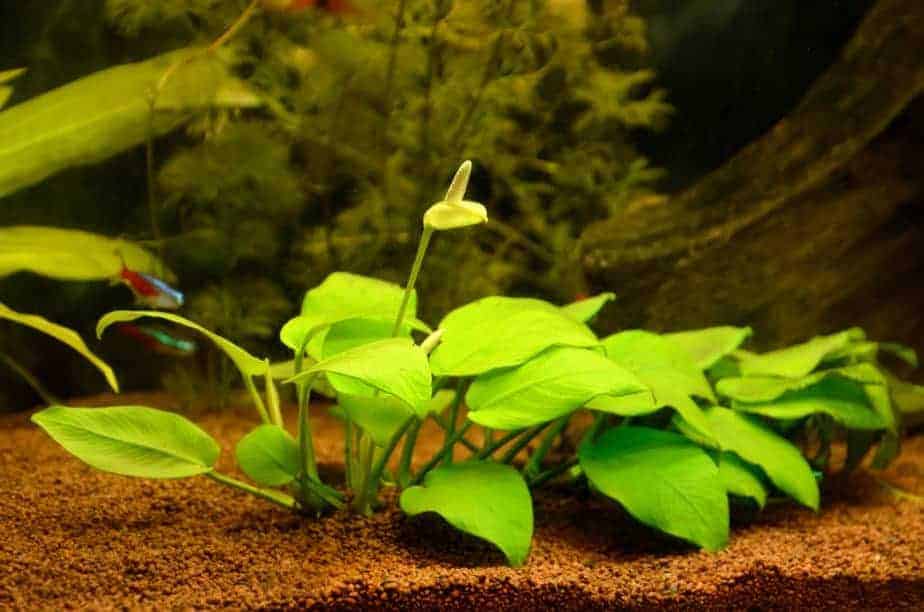
| Common name: | Anubias |
| Scientific name: | Anubias Barteri |
| Max top: | 16 inches / twoscore cm |
| Intendance complication: | Piece of cake |
| Lighting needs: | Low |
| Growth rate: | Slow |
| Additional CO2 required: | No |
| Recommended position: | Midground / Background plant |
| Fertilization: | Liquid Fertilizer |
| Availability: | Buy on Amazon |
Anubias are large plants that provide shade for a range of aquariums. They don't similar to be buried too deep, but this plant volition grow in gravel if you requite it the right care. Overall though, the Anubias is a hardy tank fixture that has uncomplicated care requirements.
Medium-light works well for the Anubias, but college levels of light can be used if you desire the largest possible plant. Fertilizer is not a must with an Anbubias, as it grows pretty well on its own, but you lot should consider putting root tabs or other nutrients in the gravel so information technology retains proficient color and health.

On the whole, be gentle with this found as yous put it into its substrate. Once more, the roots should not get in too deep and gravel should be soft and very fine. A thick layer of gravel is not necessary for this plant.
seven. Vallisneria
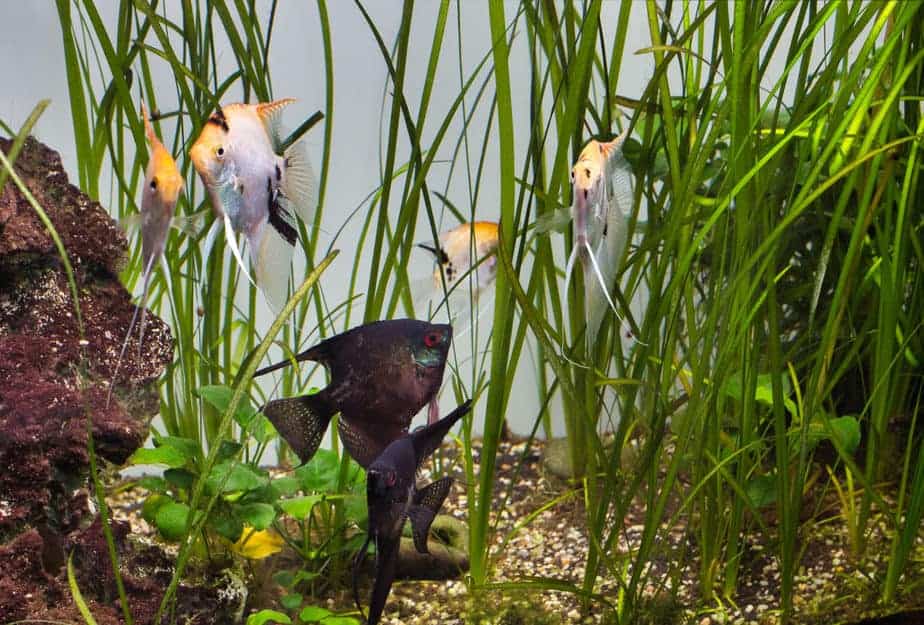
| Mutual proper noun: | Vallisneria or Val |
| Scientific proper noun: | Vallisneria Sp. |
| Max peak: | eight to sixteen+ inches / 20 to 40+ cm depending on the multifariousness |
| Care complication: | Easy |
| Lighting needs: | Moderate to Loftier |
| Growth rate: | Moderate to Fast |
| Additional CO2 required: | Not necessary |
| Recommended position: | Background found |
| Fertilization: | Root tabs |
| Availability: | Buy on Amazon |
Vallisneria is a fast-growing grass-type institute. It's plant in tropical conditions and prefers warmer h2o climates. Vallisneria doesn't require much to grow either, which makes information technology a great choice for bare aquariums that demand more coverage. You tin establish this creature around the edges of your aquarium, or have it blanket your tank.
Vallisneria grows tall and lush in a harder Ph level. Over again, the temperature should exist on the warmer side. And y'all volition want to trim it to keep it from overtaking your tank. Vallisneria can abound in gravel, but you lot don't need a ton of it. Merely a pocket-size layer should suffice, enough so that the roots can become in. The crown of your establish should stay above your substrate though!
eight. Bucephalandra
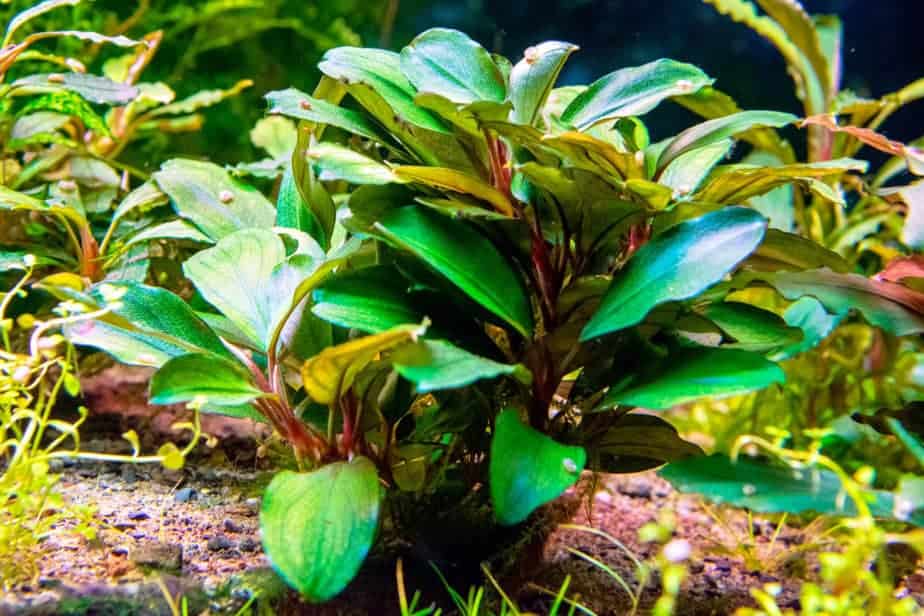
| Mutual proper name: | Bucephalandra |
| Scientific name: | Bucephalandra |
| Max height: | 4 in / 10 cm |
| Intendance complexity: | Easy |
| Lighting needs: | Low |
| Growth rate: | Slow |
| Additional CO2 required: | Non necessary |
| Recommended position: | Foreground / Midground plant |
| Fertilization: | Liquid fertilizer |
| Availability: | Purchase on Amazon |
Unlike a lot of other plants on this list, Bucephalandra volition demand thicker gravel to grow. Yous don't need massive rocks, but yous do desire something a little larger than normal gravel. You tin can put Bucephalandra on top of your substrate, or bury it a little. Simply make sure that you don't cover up the rhizome!
Porous gravel is preferred, this way the root system can grow strongly in its substrate and fully immerse itself. You can also employ other items to firmly keep your plant in place. In terms of other care tips, Bucephalandra grows wearisome in low light levels. Water temperature should exist at 71 to 82 degrees as well.
In addition, y'all can get these plants in a few different colors. And with the right maintenance, they will abound big and get a centerpiece for your tank.
nine. Waterweeds (Anacharis elodea)
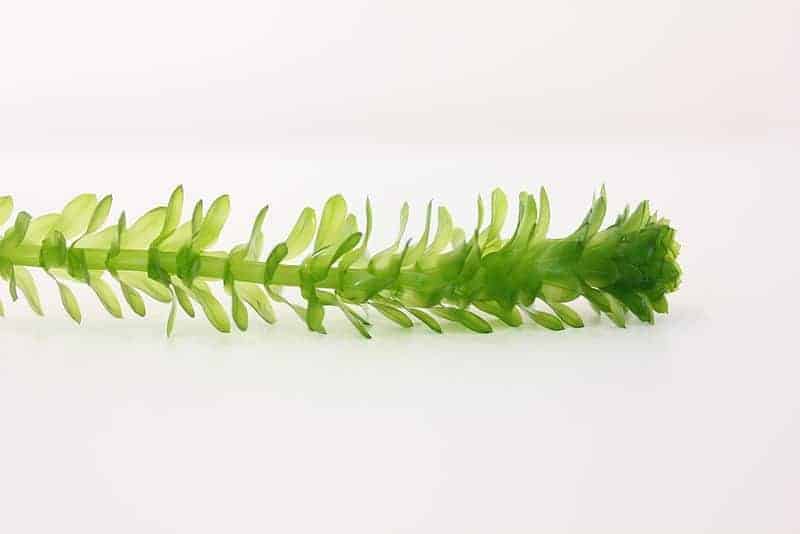
| Common name: | Brazilian Waterweeds |
| Scientific proper noun: | Egeria densa |
| Max height: | Stalk plants go along growing |
| Care complexity: | Like shooting fish in a barrel |
| Lighting needs: | Medium to High |
| Growth rate: | Fast |
| Additional CO2 required: | Not necessary, but appreciated |
| Recommended position: | Background plant |
| Fertilization: | Liquid fertilizer |
| Availability: | Buy on Amazon |
Waterweeds are a South American plant. They are cracking at keeping tank h2o well oxygenated and filtered. And similar the other plants I mentioned, waterweed can withstand many water conditions and are not picky about water temperature.
Withal, for the best institute growth, try using medium-light to illuminate your plant. If you desire a larger establish, fertilizer tin can exist used along with warmer h2o so that information technology reaches its full potential. But if you want to better command the size of your waterweed, colder water can slow its growth. Put this flora on gravel and brand sure you put your roots in deep.
They should be placed at least i-ii inches within your substrate. A thick layer of gravel is not bad for this constitute! Also, if you lot have multiple Waterweeds, make sure they are at least an inch apart. This mode they can abound fully!
ten. Dwarf Sagittaria
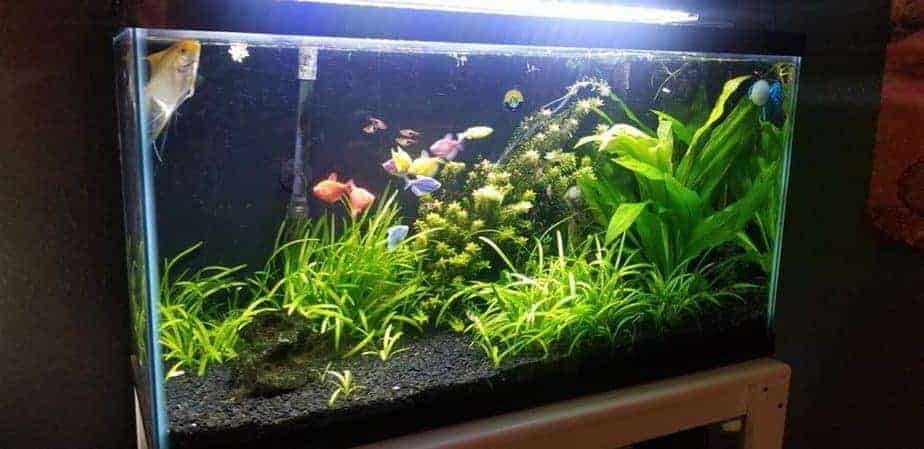
| Mutual proper noun: | Dwarf Sagittaria |
| Scientific name: | Sagittaria subulata (Sagittaria pusilla) |
| Max top: | six in / 15 cm |
| Care complexity: | Easy |
| Lighting needs: | Medium |
| Growth rate: | Fast |
| Boosted CO2 required: | Not necessary |
| Recommended position: | Foreground / Midground plant |
| Fertilization: | Root tabs |
| Availability: | Buy on Amazon |
The last plant on this list of gravel growers is the Dwarf Sagittaria. If you are looking for a hardy and adjustable plant, this is one of the best options for your aquarium. Dwarf Sagittaria are typically found in America and Columbia, so they prefer more mild water temperatures. They won't have a hard time in the h2o with a harder pH.
Nevertheless, when you gear up to plant your Dwarf, make sure you put enough of nutrients in the gravel. These plants need a lot of fertilizer to abound. And if they don't have iron they will wilt and die. When you plant your dwarf, institute it gently, but cover the roots. A picayune bit of care is all this constitute needs to thrive!
The Importance of Found Gravel
Gravel is an adaptable medium that helps root plants and keeps them in place. It'southward a great addition to aquariums and can enhance the expect of your water and aquatic greenery. And with all the varying looks and options available for this product, you tin hands find something that suits the style of your tank.
Gravel is of import to keep a biological balance in the aquarium, as they host a colony of benign leaner. For plants, the gravel is an anchor to go on them in place as well equally a source for nutrients. Finally, at that place are many different gravel varieties, which will improve the look of your tank!
Although cleaning gravel might sound like a job, it does not have to be. Click here to find some of my tips to clean gravel with minimal amounts of effort.
Many people employ gravel to cease off the expect of their aquarium. The add-on of other decoration and found material creates an overall natural and better-equipped surround for your pet. Making your tank match the natural surround of your fish is important. This not only allows your aquarium to expect better but lets you lot construct a better abode for your plants.
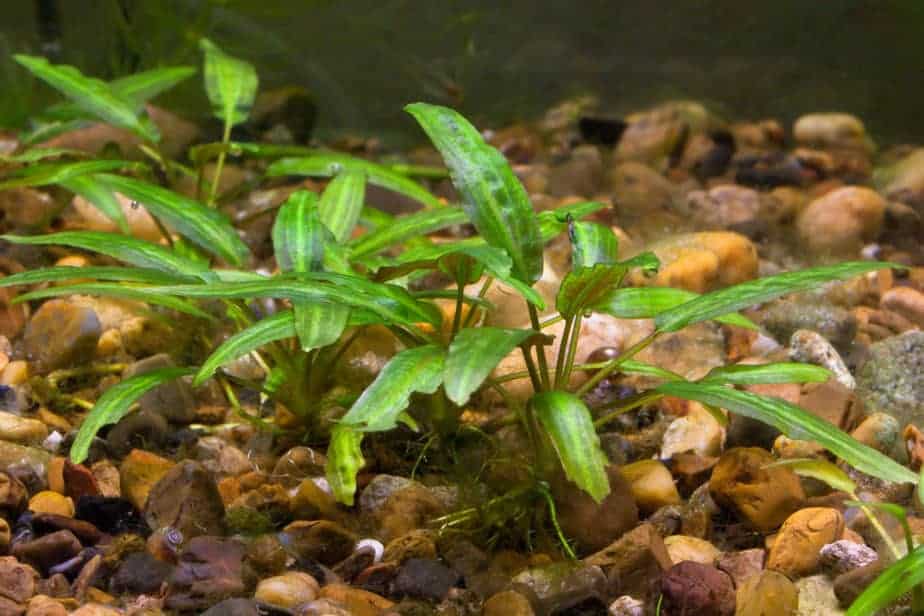
Gravel is peculiarly important for rooting plants. Some flora can go without gravel or other substrates, simply many will need something to hold them down. While there are several materials available, gravel substrate is the perfect surface for a number of establish roots. The smoothness of gravel will help plants root firmly and properly.
Certain plants rely heavily on their roots for nutrients. These plants are oftentimes referred to equally "root feeders", and it can exist difficult for a beginner to recognize which plants vest to this grouping. Therefore, I've written an article called "7 Aquarium Plants That Are Root Feeders and Need Root Tabs" which I recommend you check out. It'll really assist y'all growing plants in gravel.
For the near part, yous don't desire greenery floating in the water without roots. This could crusade wilting or institute death. Most plants need roots to absorb nutrients into their cells. Gravel allows rooting plants to grow properly and get the nutrition they need.
Gravel does not typically have nutrients in it. Simply you tin can add these in yourself with root tabs or fertilizer. Another option is to use a layer of aquarium soil underneath the gravel to provide nutrients.
My Favorite Fishtank Products to Make Life Easier
I am so happy you enjoy this postal service and then far! You will as well definitely like my product recommendations that will make your fishkeeping experience so much amend. I'm 100% sure y'all'll beloved them! Check them out here:
i. A good gravel vacuum; Without a gravel vacuum, cleaning the substrate of your tanks is near impossible. Whenever I want to remove some of the sunken detritus from the bottom of my tank I'yard happy I've got one of these. Click here
two. Liquid found fertilizer; Information technology'south no hole-and-corner that I do non like nutritious aqua-soil. It makes a mess and only works for a given amount of fourth dimension. Instead, I always utilise a liquid aquarium plant fertilizer. Everyone who keeps alive plants needs it, it's non that expensive and makes your plants abound better. Click here
3. A set of aquascape tools; I love keeping plants, but planting and reorganizing my aquarium was difficult until I got a set of these tools. Information technology's much easier to plant any kind of plant compared to using my thick fingers. Click here
4. A liquid-based water test kit; ever since I'm able to accurately exam my water parameters, keeping fish became less stressful. Before I was e'er stressed that my water parameters were wrong, merely with a kit such as the API Master kit, I can measure this. Information technology really is essential to successful fishkeeping. Click here
5. A digital thermometer; the more yous know most your aquarium, the better! Temperature is crucial for the health of your fish. A thermometer will also testify you lot whether your heaters are nonetheless working correctly. Information technology will give you more insight and more peace of mind. Click here
Choosing the Right Gravel for Your Aquarium
While gravel is crucial, you want to brand sure to pick out the right gravel for your tank. Do not buy whatever gravel you see. Often, commercial gravel from a local tool store is too large for your fish tank. Y'all demand a product that is made for fish and fish tanks to successfully root down plants!
The correct gravel for an aquarium does not take any sharp ends, is bagged with equally little dust every bit possible, and allows plant roots to grow a dumbo network. The size, shape, and texture should be consequent, which often is the example for dedicated aquarium gravel. The color is up to personal preference.
There are some features to keep in listen as yous make a buy. But something you should remember is size and shape. The gravel for fish tanks should never be chunky or sharp. Many fish like to residuum at the bottom of their tanks. And then, yous need gravel that is small and smooth in club to keep your fish prophylactic. Large sharp gravel is likewise a poor option for plants and won't give your constitute'southward roots plenty space to spread out. Consider this also.
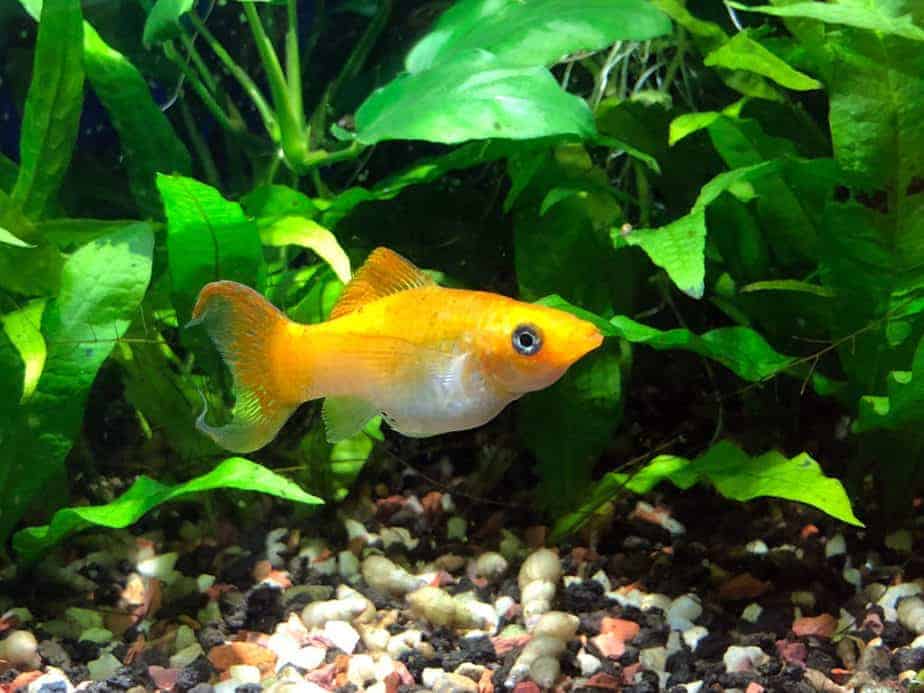
Once yous notice good-sized gravel, there are plenty of buying options. These small rocks come in several shapes, sizes, and colors. The tone of your gravel isn't important in terms of quality. But you should choose something that fits with the theme of your tank setup. A more earthy tone will await nice in a natural-looking tank.
But more than colorful or neon colors can work if you are going for an eye-popping aquarium space. The shape is also something else to recollect nearly. Some gravels are more rounded while other gravels tin be a little on the rough side. You can also find bigger gravels and fine gravels. I recommend going for fine gravel for the best planting results. Around 3-viii mm is an platonic size for institute growth.
Putting Your Plants in Gravel
The corporeality of gravel yous need in your planted aquarium depends on a few considerations. One thing to think about is tank size. With a larger aquarium, you will have to buy more gravel. Gravel ordinarily goes in before your institute. And the correct amount needs to be put in to make plants root.
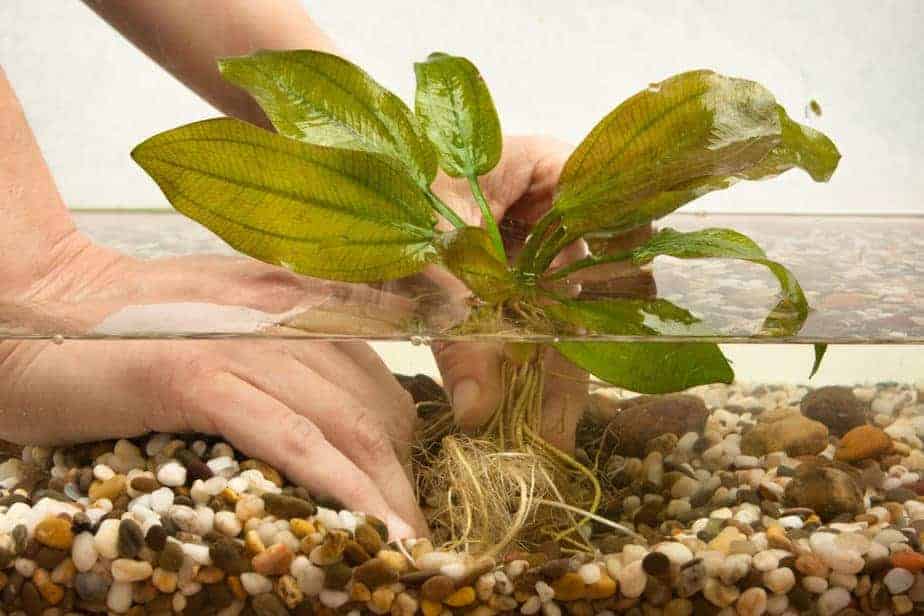
Normal tanks without plants only need an inch (3 cm) of gravel. But if you program on having plants in your tank you need a lot more. Three inches (x cm) of gravel is a general rule of thumb. If yous determine on the three-inch rule though, remember that the shape of a tank tin impact your gravel setup also. A few inches of gravel in a vertical tank is different than a few inches of gravel in a more than wide tank.
A niggling bit of research might exist necessary though. Not all plants have the same substrate needs. Plants that need to root securely will require more than gravel. Other plants do non like to be cached in a ton of gravel. And then keep this in mind!
In addition, make sure to keep your gravel clean. Aquarium gravel has a tendency to get dirty. And if you want to ensure that your plants stay salubrious you demand to maintain it. Obviously, more than gravel will make this cleaning procedure longer, but information technology is a necessary step.
To larn all most cleaning gravel in an aquarium, bank check out the page I've written a while agone chosen "How To Clean Fish Tank Gravel in 3 Easy Steps (Low Effort)". This shows you easy and convenient ways to keep your substrate make clean.
And make sure to practise some light rinsing before you put gravel in your tank. Warm water should exist used but don't wash it with cleaning products! You tin can besides apply an aquarium vacuum to make clean down substrate once information technology is established in your tank.
Live Plants in Fish Tank With Gravel
Posted by: mooreoblie1983.blogspot.com
0 Response to "Live Plants in Fish Tank With Gravel Updated"
Post a Comment